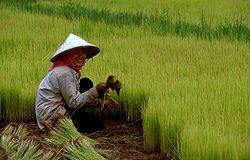Jaapi
 An Assamese Jaapi | |
| Template:Infobox instrument/Classification | |
|---|---|
| Related instruments | |
| Part of a series on the |
| Culture of Assam |
|---|
 |
Jaapi or Japi (Bodo: Khofri) is a traditional conical hat from Assam, India similar to other Asian conical hats is made from tightly woven bamboo and/or cane and tokou paat (Trachycarpus martianus) a large, palm leaf. The word jaapi derives from jaap meaning a bundle of taku leaves. In the past, plain jaapi were used by ordinary people in Assam and by farmers for protection from the sun, while ornate jaapi were worn as a status symbol by royalty and nobility. Decorative sorudoi jaapi are made with intricate cloth designs (primarily red, white, green, blue, and black) that are integrated into the weaving.
History[edit | edit source]
The medieval Chutia kings (a sub-group of Bodo-Kacharis) used the Jaapi as a cultural symbol. The last Chutia king Nitipal gifted gold and silver embroidered Jaapis to the Ahom king Suhungmung as presents in his attempts for a treaty in the year 1523.[4][5] After annexing Sadiya in 1524, the Ahom king received a lot of treasure and bounty, which included Jaapis.[6] In the year 1525, the Ahom king gifted some of the silver Jaapis obtained from the Chutia king and other items, to negotiate peace with the Mongkawng chief Phukloimung, a Shan state in present Upper Myanmar (called Nora in Buranjis) who had attacked Sadiya.[7] During the Ahom rule, Jaapi-hajiya Khel (guild for making Jaapis) was monopolised by Chutias, which indicate that they were experts in weaving Jaapis.[8] Apart from this, the Baro-Bhuyans of Central Assam are also said to have used Jaapis. As per the Satsari Buranji, the Ahom kings adopted the Tongali, Hasoti and Tokou-patia Japi from the Baro-Bhuyans.[9]
Cultural symbol[edit | edit source]
Today the jaapi is a symbol of Assam. It is worn in a style of Bihu dance, used as protection against the elements, offered as a sign of respect in ceremonies, and placed as a decorative item around the house, especially in the walls as a welcome sign.[10][11]
Originally Japi was an agricultural headgear by farmers to protect themselves from rain or sun's heat. The Bodo-Kacharis having agricultural as the main profession often used them in the rice fields. Similar headgears are also seen to be used all throughout East Asia.[12] Bishnu Prasad Rabha added Japi dance to Assamese culture through Jaymati movie from Bodo community's Khofri Sibnai Mwsanai.
Types[edit | edit source]
- Sorudoi japi: Used by women, especially brides.
- Bordoi japi: Used by royalty since ancient times (Kamrupa).
- Panidoi/Haluwa japi:Used by farmers in fields.
- Garakhiya japi: Used by cattle herders.
- Pitha japi: Used as hoods, sometimes during cultivation.
- Tupi/Varun japi: Used in rain as protective hats.
See also[edit | edit source]
Notes[edit | edit source]
- ↑ "639 Identifier Documentation: aho – ISO 639-3". SIL International (formerly known as the Summer Institute of Linguistics). SIL International. Retrieved 29 June 2019.
Ahom [aho]
- ↑ "Population by Religious Communities". Census India – 2001. Ministry of Home Affairs, Government of India. Retrieved 1 July 2019.
Census Data Finder/C Series/Population by Religious Communities
- ↑ "Population by religion community – 2011". Census of India, 2011. The Registrar General & Census Commissioner, India. Archived from the original on 25 August 2015.
- ↑ Khanikar 1991, p. 100.
- ↑ "Then the Chutiâ king desired to send silver and gold lipped Jâpi(Kup-ngiun-kham),gold bracelets(Mao-kham), gold basket(Liu-kham), gold ring (Khup-kham), gold bookstand (Khu-tin-kham), gold pirâ(Kham-ku), horse(Ma), elephant(Chang-pai), and two Âroans(Phra-nun) and Xorais(Phun) to the Ahom king."
- ↑ Mahanta 1994, p. 10.
- ↑ Bhuyan 1960, p. 62.
- ↑ "The Chutiyas were engaged in all kind of technical jobs of the Ahom kingdom. For example, the Khanikar Khel (guild of engineers) was always manneed by the Chutiyas. The Jaapi-Hajiya Khel (guild for making Jaapis) was also monopolished by them."(Dutta 1985:30)
- ↑ Bhuyan 1960, p. 135.
- ↑ Handoo 2003, p. 46.
- ↑ Assam General Knowledge. Bright Publications. p. 98. ISBN 9788171994519.
- ↑ শান্তনু কৌশিক বৰুৱা (2001). অসম অভিধান. বনলতা. pp. ১৪৪–১৪৬.
References[edit | edit source]
- Dutta, Sristidhar (1985), The Mataks and their Kingdom, Allahabad: Chugh Publications
- Khanikar, S (1991), Chutia Jaatir Itihax aru Luko-Sanskriti
- Bhuyan, Surjya K. (1960), Satsari Buranji
- Handoo, Jawaharlal (2003), Folklore in the Changing Times, Original from Indiana University: Indhira Gandhhi Rashtriya Manav Sangrahalaya


